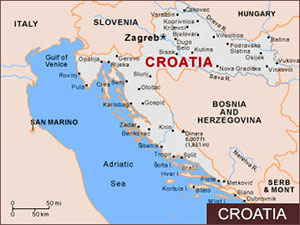Pharmacoeconomic Guidelines: Croatia
Country/Region: Croatia

Published PE Recommendations
Guide for the Economic Evaluation of Health Technologies: Croatia; as part of the Croatian Guideline for Health Technology Assessment Process and Reporting, 1st ed Zagreb, February 2011
http://aaz.hr/hr/procjena-zdravstvenih-tehnologija/smjernice
PDF in English
http://aaz.hr/sites/default/files/hrvatske_smjernice_za_procjenu_zdravstvenih_tehnologija.pdf
Published PE Recommendations Source:
Agency for Quality and Accreditation in Health Care and Social Welfare, Department for Development, Research and Health Technology Assessment. The Croatian Guideline for Health Technology Assessment Process and Reporting, 1st ed Zagreb, February 2011.
Additional Information:
Information current as of Tuesday, July 26, 2022
Key Features
| Key Features | |
|---|---|
| Type of Guidelines | Published PE Recommendations |
| Title and year of the document | The Croatian Guideline for Health Technology Assessment Process and Reporting, 1st ed Zagreb, February 2011. Part 6 Guide for the Economic Evaluation of Health Technologies: Croatia |
| Affiliation of authors | Agency for Quality and Accreditation in Health Care, Department for Development, Research and Health Technology Assessment and Academia |
| Purpose of the document | To produce credible and standardized information that is relevant and useful to decision makers in Croatian publicly funded health care system, and to meet their needs for reliable, consistent, timely and relevant HTA information. Croatian HTA reports should serve as recommendations, with aims to support policymakers at national level, particularly Croatian Ministry of Health and Social Welfare and Croatian Institute for Health Insurance, in making evidence-informed decisions on the strategic planning, investment, management and the implementation of technologies in health care, on funding (reimbursement) and coverage of health technologies, and, on hospital level, on requests from hospital directors and policy teams. |
| Standard reporting format included | Yes |
| Disclosure | Yes |
| Target audience of funding/ author's interests | Policymakers at national level, particularly Croatian Ministry of Health and Social Welfare and Croatian Institute for Health Insurance, and, on hospital level, hospital directors and policy teams. |
| Perspective | Croatian Institute for Health Insurance (as public payer) (societal perspective, including all cost and benefits outside the health care system, may be presented in addition, if considered relevant for some topics) |
| Indication | Licensed one(s) |
| Target population | Yes |
| Subgroup analysis | Yes |
| Choice of comparator | Therapies routinely used in the Croatian health system, including technologies regarded as current best practice. |
| Time horizon | Sufficiently long to reflect all important differences in costs or outcomes between the technologies being compared |
| Assumptions required | Yes |
| Preferred analytical technique | Cost-effectiveness analysis (CEA) or Cost-utility analysis, (CUA), depending on the particularities of the technology being assessed |
| Costs to be included | Yes |
| Source of costs | Direct cost relevant to Croatian Institute for Health Insurance (where measurable and relevant, indirect costs and cost falling outside of Croatian Institute for Health Insurance should be reported separately) |
| Modeling | Yes |
| Systematic review of evidences | Yes |
| Preference for effectiveness over efficacy | Yes, modeling and/or sensitivity analysis should be used to extrapolate efficacy data |
| Preferred outcome measure | Measure of health effects: Natural units (CEA) or QALYs (CUA) Measurement of QALY gains: Reported directly by patients and/or informal caregivers |
| Preferred method to derive utility | EQ-5D |
| Equity issues stated | Yes |
| Discounting costs | An annual rate of 5% on both costs and health effects (in sensitivity analyses between 3% and 10%) |
| Discounting outcomes | An annual rate of 5% on both costs and health effects (in sensitivity analyses between 3% and 10%) |
| Sensitivity analysis-parameters and range | On uncertain parameters |
| Sensitivity analysis-methods | Probabilistic sensitivity analysis |
| Presenting results | For clarity, reproducibility, and future use of data, results of total costs and total gains should be clearly stated |
| Incremental analysis | Yes |
| Total costs vs effectiveness (cost/effectiveness ratio) | Yes |
| Portability of results (Generalizability) | Yes |
| Financial impact analysis | Budget Impact Analysis (BIA) is mandatory for submission to the Croatian Health Insurance Fund, and this should be done according the ISPOR BIA Task Force Report, see additional information above. |
| Mandatory or recommended or voluntary | Recommended |
Acknowledgement: